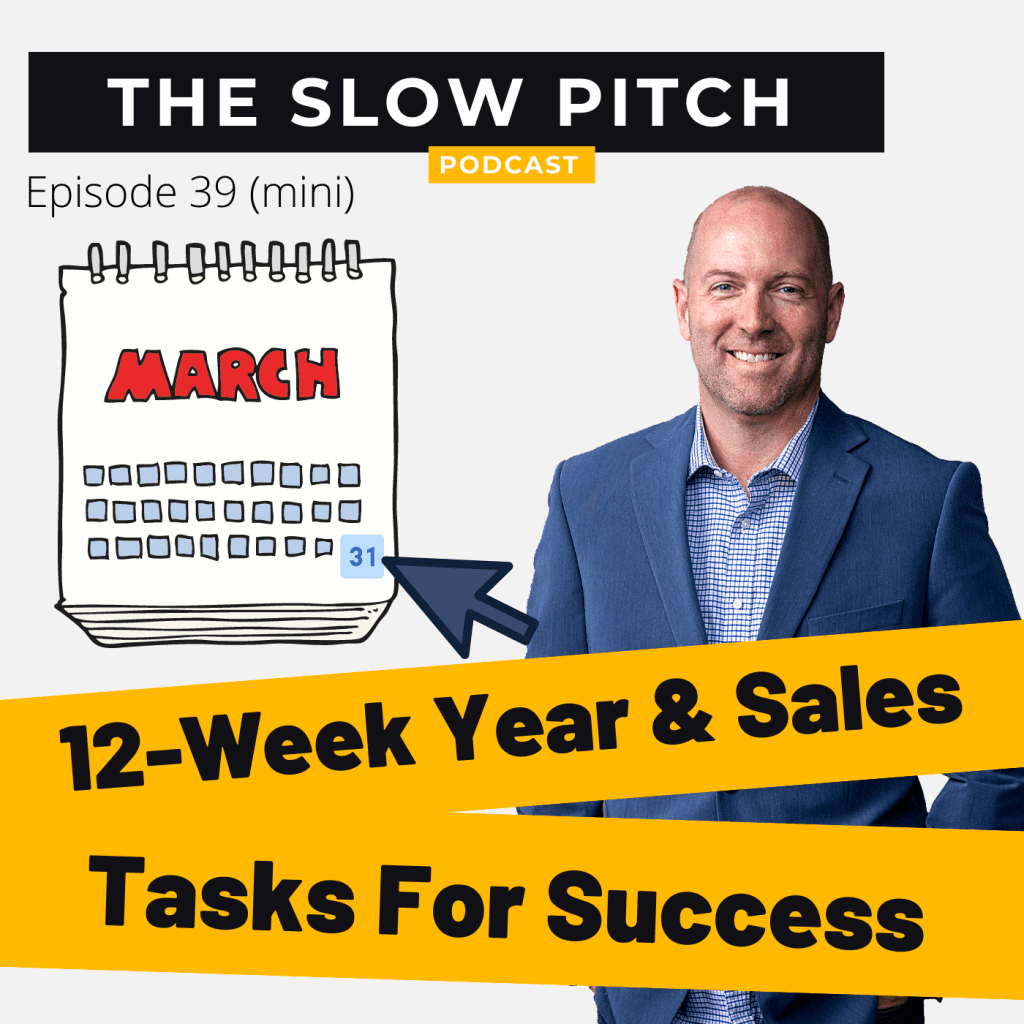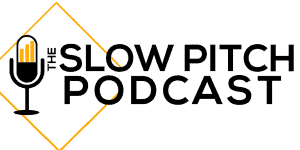The 12-Week Year and Sales – Stay Focused


Notes
How To Use The 12-Week Year in Sales
Last year, we talked about using the 12-Week Year (by Brian Moran) in your sales planning process. The 12-Week Year is a book based on breaking down each year into four quarters to better achieve your sales goals. In this episode, we’re talking about the 12-week year and sales. How are you doing? The first 12 weeks of 2022 have come and gone and I’m curious…did you hit your goal?
Someone once told me that when times are really good, it’s easy to sell. When times are not so good (economy slowed down, like in 2008), it’s much more difficult to sell. Or so you think.
The 12-week year is critical in building sales incrementally and with purpose. By identifying the important tasks you must do to make your sales goal in 12 week increments becomes paramount to achieving a year-end goal beyond your expectations.
I can say this without question: When you know what you must do every 12 weeks and whether you’re on track, behind, or ahead, you’ll make faster task adjustments that will course correct along the way instead of being surprised in November that you won’t make your goal.
In this episode, Rob talks about the top 5 things you need to pay attention (think measure) to to hit your 12-week sales goals.
Related Episodes:
Increase Sales Conversion Using the 12-Week Year
Top 10 Sales Tips For Beginners
Sales Call Tips – Dealing with Hostile People
NOTE: Some links may be affiliate links, which means we get paid a commission when you purchase, but it the cost remains the same for you.
Music: "Clydesdale Funk" by Cast of Characters, written by: Dustin Ransom.
The Episode
Rob 00:08
Welcome back to The Slow Pitch. And this episode is going to be about the 12. Week year, and how to use it in sales. Here’s why I want to talk about right now, the first quarter has just ended, which means your first 12-week year has just passed. And if you’re using the 12-week year to guide yourself into getting and achieving your sales goals, my question to you is, how are you doing? Did you hit your goals? Did you make it? Are these the things that you wanted to get done? They’re all done, or did you not quite get there? Let’s get started.
V/O 00:42
This is The Slow Pitch Podcast.
Rob 00:46
All right, getting started in the 12-Week Year. Just … let’s do a little quick refresher, because it’s been a little while since we’ve talked about on this episode. The 12-Week Year was a book by Brian Moran, and Michael Lemington. And basically, the concept came from a when you set a goal, when you set something you’re trying to get done, and you set it up for… you know it’s gonna be a long haul, it’s gonna be a long time to get there… what happens is people come out of the gate really strong, like they’re ready to go, and they call it kind of like an early spurt, they, just kind of go. And it’s, you’re excited, this is my goals. And then somewhere around three, four or five weeks, depending on who you are, what you like to do, and how your style is, and all that kind of stuff, you start to slow down, or you might slow down after several weeks or several months. But somewhere in the middle of this long-term goal that you’ve set for yourself, there’s a little bit of a lull. And during that lull, that’s when the danger sets. And that’s when things don’t happen like they’re supposed to. You’re not doing the things you’re supposed to be doing, there’s actions that are not being done. And that’s where you run into trouble. And then what happens is you get to the end of the year, and all of a sudden you go, “Oh my goodness, we’re not going to make this goal.” And so you start hustling really hard. And the question becomes what if you hustled really hard all year? Well, that’s difficult to do. So his concept or their concept was this, let’s eliminate the lull by making shorter goals that get you to the longer term goal. All makes sense, right? These are, these are the smart steps that you should be taking anyway. But not everybody does. So basically, during the first 12 weeks, the first quarter, you’ve got to set a goal, that’s going to get you to your end of year goal. And so if you know your end of year goal is… just for round numbers 100… could be thousand, it could be dollars, it could be whatever could be 100, whatever that is, if you’re going to divide it into four quarters evenly, it’s 25 each, right? So, if you divide each one evenly, that’s one thing, if you want to spread it out a little differently front-load it, back-load it… however, you know your style or your system works, that’s where you’re gonna have to tweak and adjust. What’s important is that this is the goal that you have to achieve at the end of the 12 weeks. So if it’s a certain number of phone calls a certain number of activities, that’s where you end up using this time frame to get that particular number of things done. And the concept behind it to also goes into you want to reduce your excuses. So you’re going to be very clear about what your goals are. So for some people being very clear means a specific number, or a specific task or a certain certain number of things that you have to do. And then the next thing you have to do is kind of like plan daily plan weekly, what does it take to get to where you want to go? Be very specific. And then the last part of that is just planning and executing it quickly. Basically, what you’re doing is you’re evaluating are you achieving your goal? Or are you not on a daily basis, or on a monthly basis or on a weekly basis, whatever that makes sense for what that type of goal is. And you know, what you’re doing is you’re scoring yourself. And you’re saying yes, I have or No, I haven’t. It’s a yes or no, there’s no in between. Well, I could have done well, if I would have counted. No, no. Did you? Or did you not do what you said you were going to do to get to your goal. And you’re activity focused, not results focused. And that’s a little bit of a mind twist for yourself that you have to go through, you’re not focused on: Did I have the results I wanted. Did I hit my sales goal, that’s not the result you want to focus on. The result or the activity you want to focus on are all the different elements of the of the tasks that you have to go through to get your sale? So that can be as simple as how many cold calls? How many meetings? How many purposeful conversations? How many times did you have a conversation with somebody before they actually set their first meeting? All these different things add up to the likelihood or a greater likelihood of you actually getting a meeting and or getting a sale at the end. So no matter whether you get the sale or not, it doesn’t matter. If you know that in order to get one sale, it takes about three weeks. In that three weeks, you have to have an initial conversation, a follow up conversation, and then a review of whatever you’re going to go through in the estimate, let’s say and a confirmation of what you’re doing to get the signed contract and get the check that let’s say take three weeks. Each one of those should be something you’re measuring And because you’re not measuring that you may not know that you’re not doing all the functions or activities that you should be leading up to that. So that’s the concept. And so the next thing I want you to think about is quarter one just finished. Did you hit your goals? And if you did hit your goal for the quarter… And if you’re measuring it incorrectly, you might be well, I hit my sales goal. Okay, great. But did you do all the activities? And were you measuring that in what you did to get your goal? Your result… Is it repeatable? Could you put your finger on exactly what you did to get to that goal? If you cannot? Then you really need to answer the question, “No, I didn’t hit my goal.” Because if you can’t attribute to what it’s from, then then you really didn’t hit your goal I had somebody tell me one time, sales are easy when, when things are going really well, it’s when things are going slower, tougher, it’s the grind of getting through the activities that you have to go through. When everybody’s saying no, disappearing, you know, you call them you have a meeting, and then they don’t want to talk to you ever again, all those types of things. While you have to measure that those are the times that you have to do more of it, right? And that’s where it’s difficult because a lot of people want to give up during that time, or they don’t have enough in their pipeline to be able to do that.
V/O 06:18
Do you have a question about sales? Call or text your question at (608) 708-SLOW, that’s 608-708-7569. Or you can email them to Questions@TheSlowPitch.com. Now, back to the show.
Rob 06:36
So if your answer to yourself, no, I didn’t hit my, my goal, my activities, my my things that I should be doing to get my my sales, then that’s okay. That’s okay. It’s all you’re only 12 weeks into the year, you still have three quarters of the year left in front of you, right? So now, what activities should you be doing? Better yet? What activities did you do to actually get something to happen? If you did some activities that actually created results for yourself? That’s a great place to start. Are you recording those things that you should be doing? And are you measuring them, and if you’re not measuring them every day, honestly, you’re missing out, you’re you’re there’s a cost, there’s some satisfaction saying I did everything I could today to get to my goal in the next 12 weeks. Or I’m no, I’m going to hit my goal, the end of the year, because I’m doing everything I should be doing. Because I can show every day these are the things that I’ve done. And I can take notes, I have created a form, that every day that I know that I need to get these, you know, I think it’s like 10 or 15 things that have to be done every day, and sometimes or every other day. So you know that it’s basically the way I have it written out for myself is every week, I have to have a certain number of things. And sometimes they boil down to one a day. And sometimes they boil down to one every other day. So when I go through that activity every day, I can look at it go I did want us to do, that’s all I can ask of myself, because eventually something’s going to close. And I always want to remind everyone, that the one phrase that makes the most sense, in business, in business in general, but in sales as well… And that is, “What gets measured, gets done.” So create that checklist. Create a spreadsheet if you have to with a list of things that you have to do every day or every other day, put it all on one form so that every day of the week, you can see where you’re at check marks, counts, whatever you need to do, make sure you’re measuring the activities that generate sales every day. And that will guarantee results by the end of the year. So until next time, go out there and do the activities that you have to do.
V/O 08:47
Thank you for listening to The Slow Pitch. Slow Down and Close More.
Rob 09:07
Thanks as always for listening today. If you like this podcast, please subscribe and leave us a review. We really appreciate it. Follow us on Twitter, Instagram and Facebook at The Slow Pitch. We were mixed today as always by Johnny Polakis. And we were produced by High Gravity Studios. Music credits and other notes are in the show notes section on TheSlowPitch.com And we’ll be back with another episode soon.








